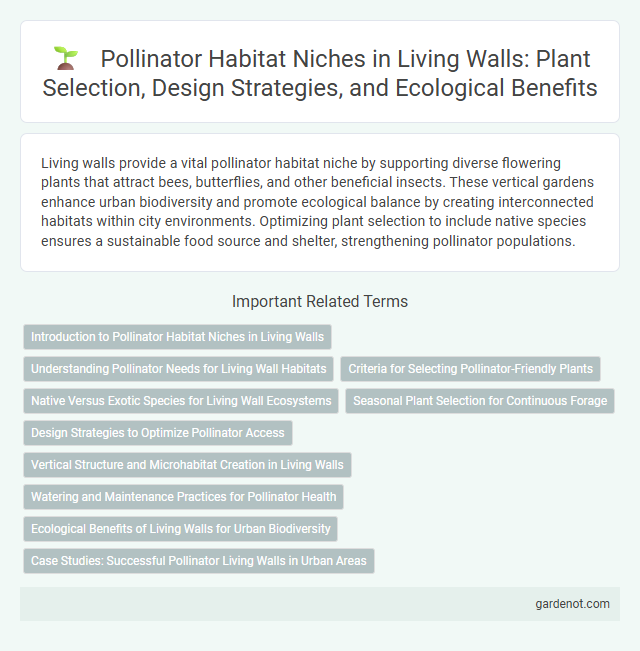Living walls provide a vital pollinator habitat niche by supporting diverse flowering plants that attract bees, butterflies, and other beneficial insects. These vertical gardens enhance urban biodiversity and promote ecological balance by creating interconnected habitats within city environments. Optimizing plant selection to include native species ensures a sustainable food source and shelter, strengthening pollinator populations.
Introduction to Pollinator Habitat Niches in Living Walls
Pollinator habitat niches in living walls provide essential resources such as nectar, pollen, and shelter for bees, butterflies, and other pollinating insects. These vertical gardens mimic natural ecosystems by incorporating diverse plant species that bloom sequentially, ensuring continuous food supply throughout the seasons. Integrating pollinator-friendly flora in living walls enhances urban biodiversity and supports ecosystem services critical for food production.
Understanding Pollinator Needs for Living Wall Habitats
Living wall habitats designed to support pollinators must incorporate a diverse range of native flowering plants that provide continuous nectar and pollen sources throughout the growing season. Structural complexity, including varying heights and densities of vegetation, creates microhabitats that cater to different pollinator species' nesting and foraging behaviors. Ensuring access to water, shelter from predators, and minimal pesticide exposure further optimizes living walls as sustainable pollinator habitat niches.
Criteria for Selecting Pollinator-Friendly Plants
Selecting pollinator-friendly plants for a living wall involves prioritizing native species that provide abundant nectar and pollen throughout the growing season. Plants with diverse flower shapes, colors, and bloom times support a wide range of pollinators including bees, butterflies, and hummingbirds. Ensuring plant variety and avoiding pesticides enhances habitat quality and promotes sustainable pollinator populations.
Native Versus Exotic Species for Living Wall Ecosystems
Native species in living wall pollinator habitats support local biodiversity by providing familiar nectar and pollen sources, promoting ecosystem resilience. Exotic species may offer extended blooming periods but can disrupt native pollinator interactions and outcompete indigenous plants. Incorporating a balance of native plants enhances ecological function and pollinator diversity within living wall ecosystems.
Seasonal Plant Selection for Continuous Forage
Selecting a diverse range of seasonal plants for living walls ensures continuous forage availability, supporting a robust pollinator habitat niche throughout the year. Incorporating native flowering species with staggered bloom times maximizes nectar and pollen resources for bees, butterflies, and other pollinators. This strategic plant selection enhances biodiversity, promotes pollinator health, and sustains ecosystem services across changing seasons.
Design Strategies to Optimize Pollinator Access
Design strategies for living walls to optimize pollinator access emphasize incorporating native flowering plants with staggered bloom periods to provide continuous nectar sources. Structural features such as varied flower shapes and depths cater to diverse pollinator species, including bees, butterflies, and hummingbirds. Vertical layering and modular planting enhance habitat connectivity, facilitating pollinator movement and increasing overall biodiversity in urban environments.
Vertical Structure and Microhabitat Creation in Living Walls
Living walls offer a complex vertical structure that enhances pollinator habitat niches by providing diverse foraging and nesting opportunities within limited urban spaces. The microhabitats created by varied plant species and substrate types support a range of pollinators, including bees, butterflies, and other beneficial insects, promoting biodiversity. These microenvironments optimize light, moisture, and shelter conditions, critical for sustaining pollinator populations in densely built environments.
Watering and Maintenance Practices for Pollinator Health
Watering practices for pollinator habitat niches in living walls should prioritize consistent moisture levels to support native flowering plants favored by bees and butterflies. Maintenance routines must avoid pesticide use and include seasonal pruning to enhance bloom cycles and nectar availability. Proper irrigation systems, such as drip lines, reduce water wastage while maintaining optimal hydration critical for pollinator health and biodiversity.
Ecological Benefits of Living Walls for Urban Biodiversity
Living walls create vital pollinator habitat niches by offering diverse floral resources and nesting sites within dense urban environments, supporting bees, butterflies, and other pollinators crucial for ecosystem health. These vertical gardens enhance urban biodiversity by connecting fragmented green spaces, facilitating species movement and genetic exchange in cities. Incorporating native plants in living walls optimizes pollinator attraction, improves urban ecological resilience, and contributes to sustainable urban ecosystem services.
Case Studies: Successful Pollinator Living Walls in Urban Areas
Urban living walls provide critical pollinator habitat niches by integrating native flowering plants that attract bees, butterflies, and other pollinators, thereby enhancing biodiversity in city environments. Case studies from cities like Melbourne and Toronto demonstrate that strategically designed living walls increase pollinator visitation rates by up to 45%, supporting essential ecosystem services despite limited ground space. These installations often incorporate layered plantings and seasonal floral diversity to sustain pollinator populations year-round, showcasing effective urban ecological restoration practices.
Pollinator habitat niche Infographic

 gardenot.com
gardenot.com